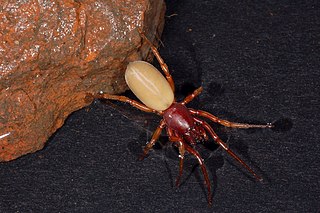
Dysderidae, also known as woodlouse hunters, sowbug-eating spiders, and cell spiders, is a family of araneomorph spiders first described by Carl Ludwig Koch in 1837. They are found primarily in Eurasia, extending into North Africa with very few species occurring in South America. Dysdera crocata is introduced into many regions of the world.

Oenanthe, known as water dropworts, oenanthes, water parsleys, and water celeries, are a genus of plants in the family Apiaceae. Most of the species grow in damp ground, such as in marshes or in water.

The woodlouse spider is a species of spider that preys primarily upon woodlice. Other common names refer to variations on the common name of its prey, including woodlouse hunter, sowbug hunter, sowbug killer, pillbug hunter and slater spider.

Oenanthotoxin is a toxin extracted from hemlock water-dropwort and other plants of the genus Oenanthe. It is a central nervous system poison, and acts as a noncompetitive antagonist of the neurotransmitter gamma-aminobutyric acid. A case has been made for the presence of this toxin in local Oenanthe species playing a causative role in euthanasia in ancient Sardinia. It was crystallized in 1949 by Clarke and co-workers. It is structurally closely related to the toxins cicutoxin and carotatoxin. Oenanthotoxin is a C17 polyacetylene isomer of cicutoxin.

Tillandsia crocata is a species in the genus Tillandsia. This species is native to Brazil, Bolivia, Argentina, Paraguay and Uruguay.
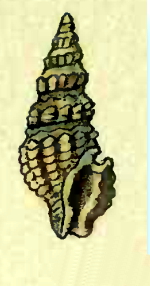
Zonulispira crocata, common name the Sanibel turrid, is a species of sea snail, a marine gastropod mollusc in the family Pseudomelatomidae.

Acontia crocata is a moth of the family Noctuidae. It is found from India to Australia. In 2003, it was recorded from Deux-Sèvres in France.

Lambis crocata, the orange spider conch, is a species of large sea snail, a marine gastropod mollusc in the family Strombidae, the true conchs.

Mycena crocata is a species of agaric fungus in the family Mycenaceae. The common name saffrondrop bonnet refers to the red or orange latex that it exudes if the stipe is broken. Its habitat is woody debris and leaf litter in deciduous woodland, especially beech.

Desmiphora is a genus of longhorn beetles of the subfamily Lamiinae, containing the following species:
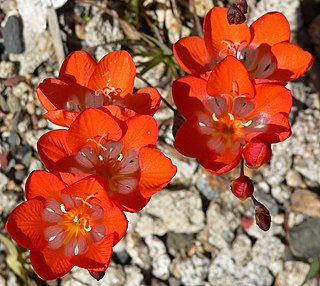
Tritonia crocata is a plant species in the family Iridaceae.

Oenanthe crocata, hemlock water-dropwort is a flowering plant in the carrot family, native to Europe, North Africa and western Asia. It grows in damp grassland and wet woodland, often along river and stream banks. All parts of the plant are extremely toxic and it has been known to cause human and livestock poisoning.
Desmiphora neoflavescens is a species of beetle in the family Cerambycidae. It was described by Galileo and Martins in 1998. It is known from Brazil.
Desmiphora santossilvai is a species of beetle in the family Cerambycidae. It was described by Galileo and Martins in 2003. It is known from Brazil and French Guiana.
Desmiphora auatinga is a species of beetle in the family Cerambycidae. It was described by Martins and Galileo in 1996. It is known from El Oro: Machala Ecuador.
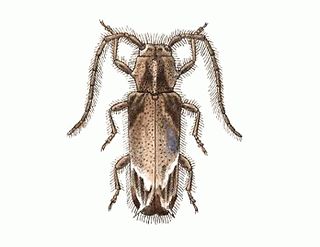
Desmiphora canescens is a species of beetle in the family Cerambycidae. It was described by Henry Walter Bates in 1874. It is known from Colombia, Mexico, and Venezuela.
Desmiphora picta is a species of beetle in the family Cerambycidae. It was described by Stephan von Breuning in 1943. It is known from Argentina.
Desmiphora maculosa is a species of beetle in the family Cerambycidae. It was described by Linsley and Chemsak in 1966. It is known from the Galapagos Islands.
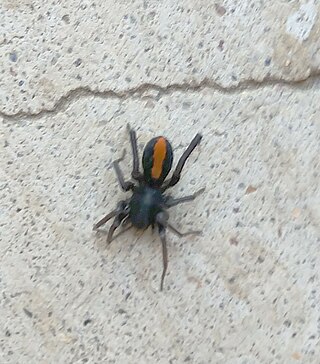
Castianeira crocata is a species of true spider in the family Corinnidae, sometimes called by the common name red stripe spider. The species was first described by Nicholas Marcellus Hentz in 1847. It is found in the United States. Though its body shape is quite different, its characteristic black body and red-marked back puts it at risk of being mistaken for a black widow spider.

Goeppertia crocata, the saffron-coloured calathea or eternal flame plant, is a species of flowering plant in the family Marantaceae, native to Bahia and Espírito Santo states of eastern Brazil. It has gained the Royal Horticultural Society's Award of Garden Merit as a hothouse ornamental.














